Planting Plans To Attract Hummingbirds: 5 Combinations For Beds And Pots
Hummingbirds are delightful garden visitors in the spring and summer. Discover key planting palettes to attract these precious pollinators and support wildlife.
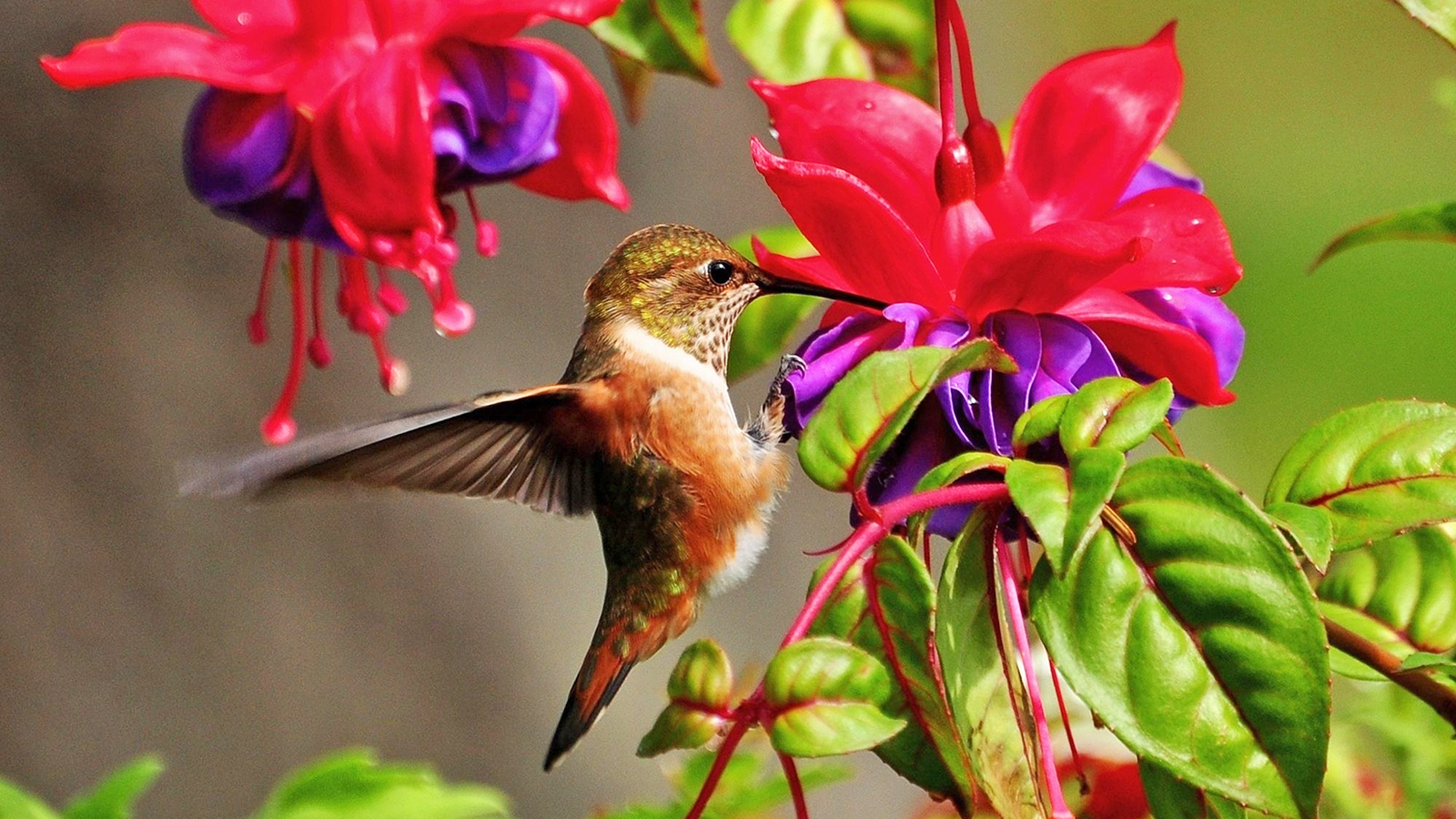

Melanie Griffiths
Each spring and summer, tiny winged creatures can be seen flitting here and there along forest edges, in meadows, and in suburban and rural gardens. No, they aren’t bees, moths, or beautiful butterflies but another of nature’s important pollinator species – the hummingbird.
Most of the world’s nearly 340 hummingbird species are native to the western hemisphere where they can be found living in deserts, mountains, and tropical locales where there’s a mix of tall trees, an underlayer of shrubs, and open fields.
Your own backyard is fair game, too, made even more appealing with plants for hummingbirds that can help sustain their incredibly fast metabolism. With their intensely beating wings and their Blue Angels-style flight patterns, hummingbirds burn between 6,000-12,000 calories each day and must refuel every quarter hour.
With fewer forest edges and meadows available as urban development expands, suburban gardens are playing a greater role in providing food and shelter for these amazing creatures.
Below are five garden planting recipes that will help you attract and support hummingbirds. Always include plants that are suited to your USDA Hardiness Zone and ensure your plants are appropriate for your soil type, light levels, and moisture conditions.
1. Spring Flowers For Early Arrivals
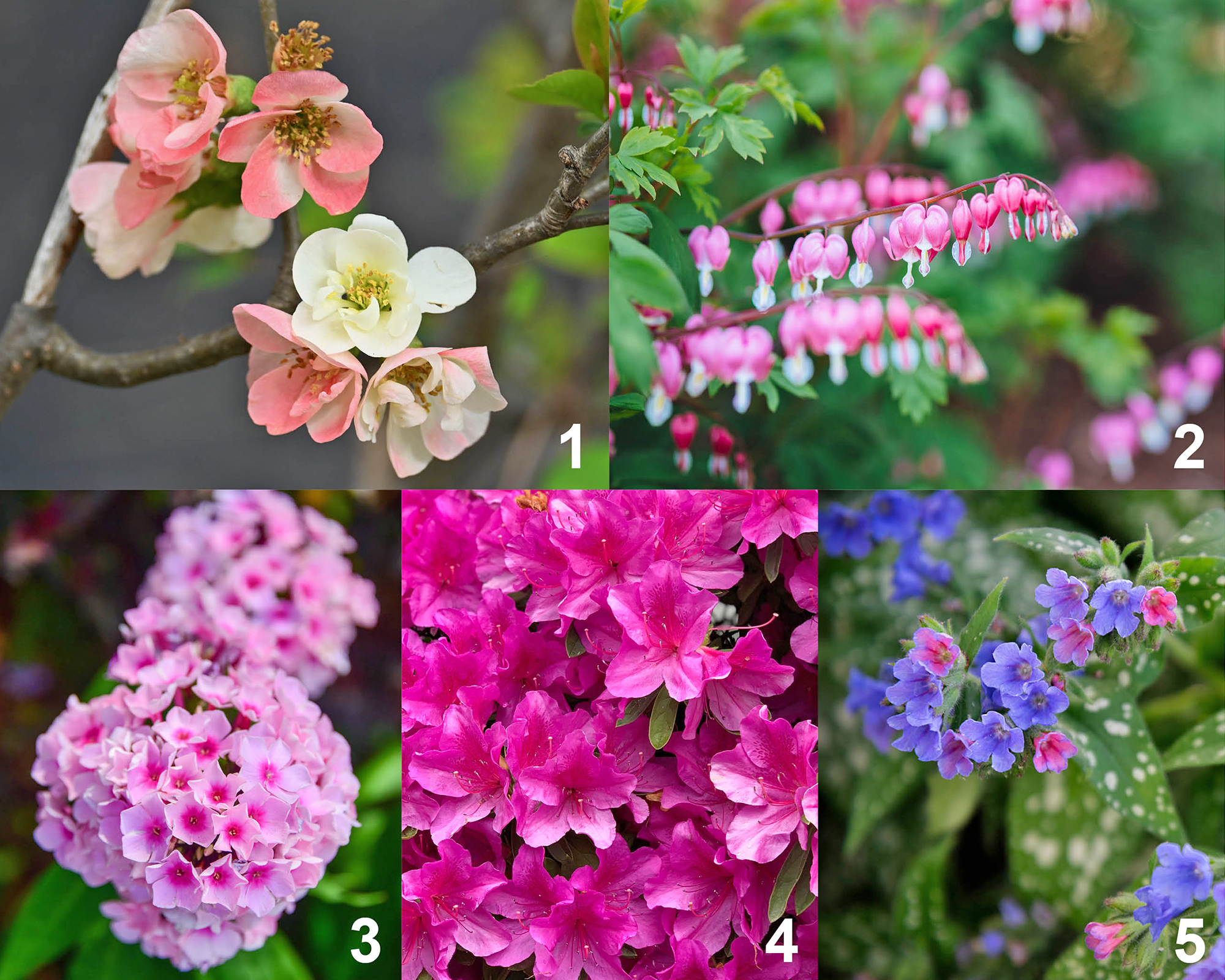
Hummingbirds rely on spring-flowering plants such as perennials and small shrubs to sustain them as they arrive in spring. A garden bed with the following spring bloomers offers a staggered flowering schedule to last throughout the season:
- Flowering Quince (Chaenomeles speciosa) Available in shades of red, pink and orange, you may even get a crop of quince fruits at the end of the growing season. Use flowering quince as a small tree or a large shrub. Full sun. USDA Zones 5-7.
- Bleeding Heart (Lamprocapnos spectabilis) This woodland plant thrives in dappled shade in early spring, then fades away in summer. USDA Zones 2-9.
- Garden Phlox (Phlox paniculata) Hummingbirds love garden phlox’s nectar-filled blooms in spring, and bonus for you – it’s fragrant! Full sun. USDA Zones 4-8.
- Azalea (Azalea hybrid) Many azalea varieties are available in the color range best seen by hummingbirds – reds, pinks, and oranges. These shrubs range in height from 2.5-6ft tall. Partial to full sun. USDA Zones 3-7.
- Lungwort (Pulmonaria spp.) This low-growing early spring bloomer attracts both bees and hummingbirds. Use in the front of a border to feature its silver-spotted leaves through summer. Partial to full shade. USDA Zones 3-9.
2. Summer’s Abundance of Annuals
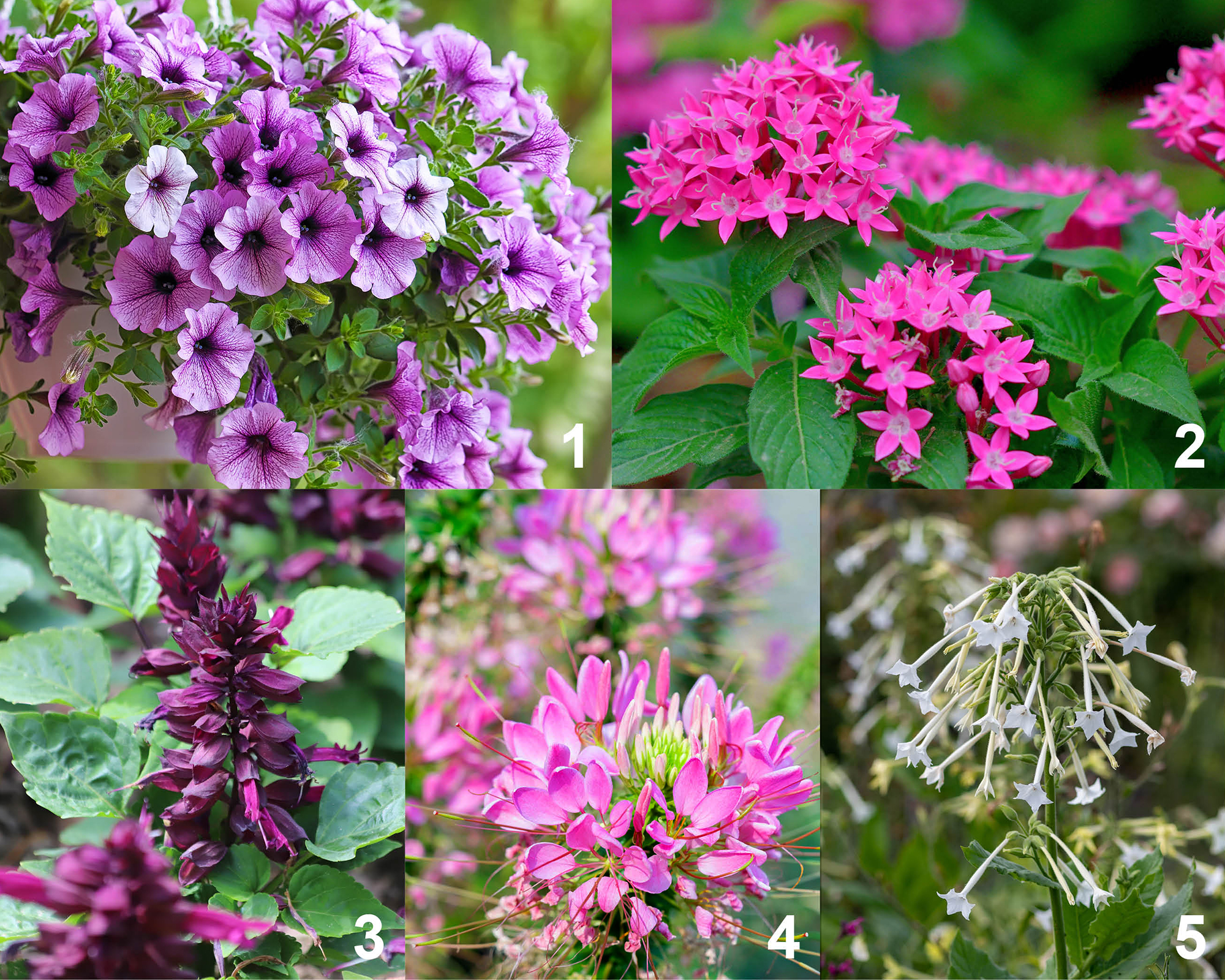
Summer-flowering annuals are fast-growing and full of blooms all season long – just what their hummingbird visitors require. Best of all, they add pops of color to new or existing garden beds.
Sign up for the Gardening Know How newsletter today and receive a free copy of our e-book "How to Grow Delicious Tomatoes".
- Petunias (Petunia hybrids) In a range of colors and flower sizes, petunias are a standby for pollinators of all persuasions. Use as a rolling groundcover. USDA Zones 9-11.
- Pentas (Pentas lanceolata) With flower heads filled with star-shaped blooms, pentas are low-maintenance, heat- and humidity-loving plants beloved by hummingbirds and butterflies. 1-3ft tall. USDA Zones 9-11.
- Scarlet Salvia (Salvia spendens) Annual salvia’s 2-3ft tall flower spikes are filled with tubular blooms all summer long. Use as a low- to mid-height element in your garden bed. USDA Zones 10-11.
- Spider Flower (Cleome hassleriana) Cleome’s tall stems are topped with delicate round flower heads, each with dozens of tubular blooms. At upwards of 5-6ft tall, use cleomes in the rear of a garden bed. USDA Zones 10-11.
- Flowering Tobacco (Nicotiana sylvestris) Tubular flowers abound on this 4-5ft tall annual. Available in a range of hues preferred by hummingbirds, it also delights humans with its evening fragrance. USDA Zone 10.
3. Waterwise and Nectar-Filled
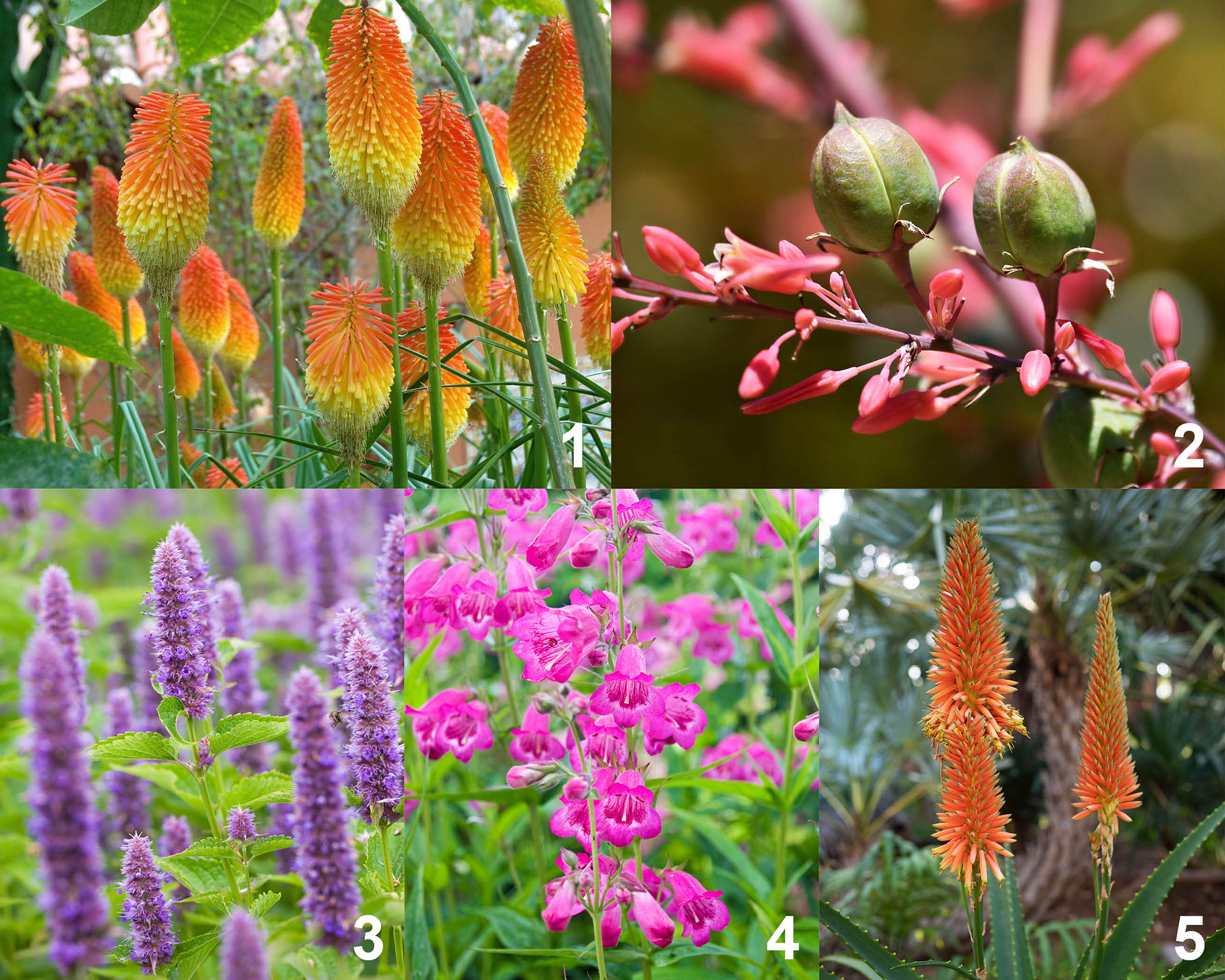
For those in warm, arid environments, a host of drought-tolerant plants are beloved by hummingbirds.
- Agastache (Agastache spp.) There’s a reason this plant’s common name is hummingbird mint! They flock to its nectar-filled flowers on spikes up to 4ft tall. There are many species and varieties to choose from, all of which are drought-tolerant. USDA Zones 3-10.
- Penstemon (Penstemon digitalis) Also known as beardtongue, Penstemon also has tall flower spikes loaded with tubular flowers. Once established, penstemons are drought tolerant and need very little care. USDA Zones 3-9.
- Red Hot Poker (Knifophia uvaria) Another perennial with tall spikes, red hot poker’s red, orange, and yellow-tipped tubular flowers shine in a dry landscape. Clump them together or use as a focal plant in a succulent garden. USDA Zones 5-9.
- Aloe (Aloe spp.) This low-water succulent produces 2-4ft tall spikes tipped with orange, red and yellow tubular flowers. They’ll often repeat their blooms throughout the growing season, offering hummingbirds a double dose of nectar. USDA Zones 9-11.
- Yucca (Hesperaloe parviflora) Another waterwise desert plant, yuccas come in a variety of colors and sizes. Tall spikes flower for weeks at a time and are eagerly visited by hummingbirds. USDA Zones 5-9.
4. Bring Them Closer with Containers
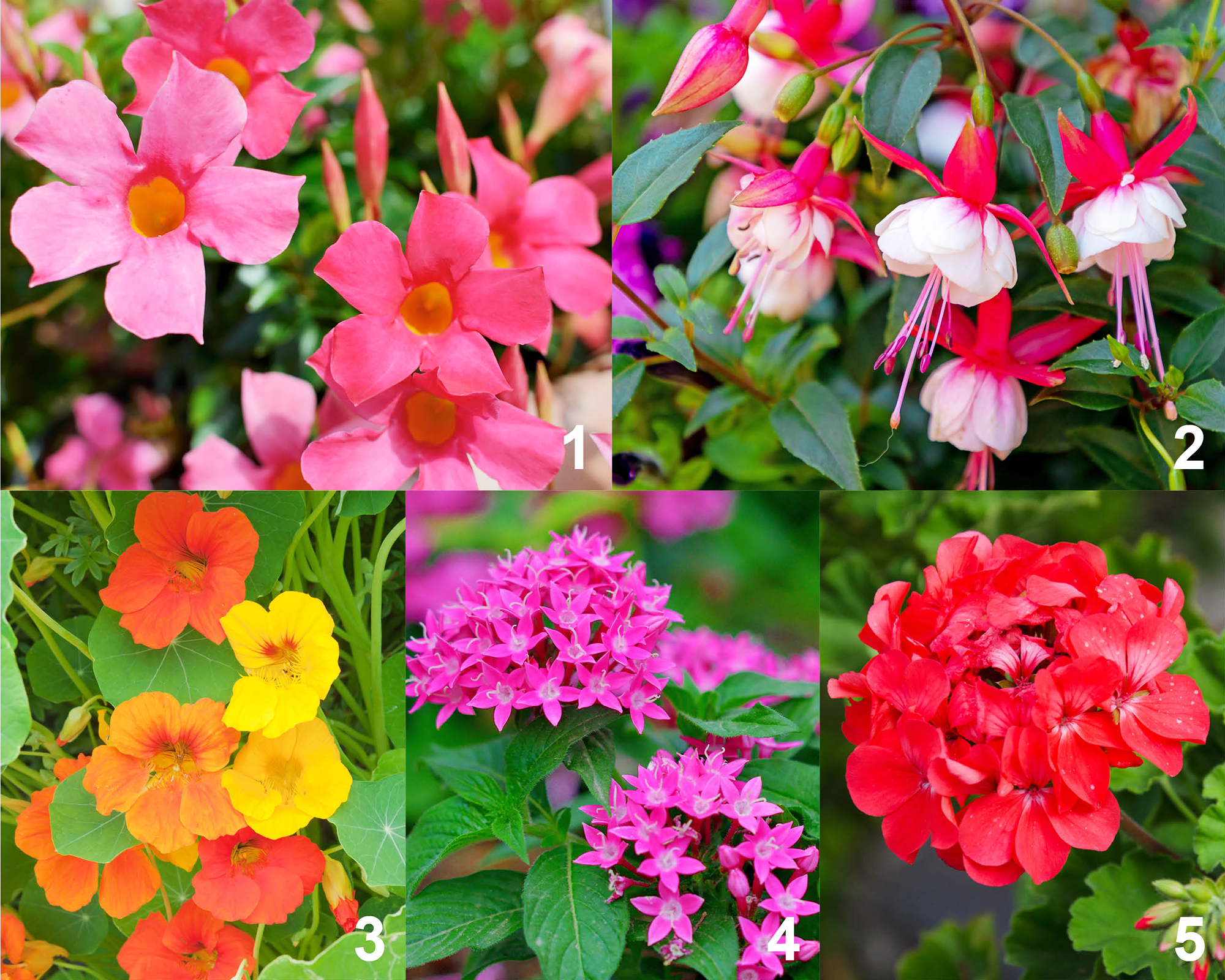
Can’t see hummingbirds all the way out in your garden? Lure them into view by placing hummingbird-friendly flowers in patio containers. Plant in individual pots and then group together, or plant in one large container.
- Mandevilla (Mandevilla hybrids) Use this large-flowered tropical vine as a “thriller” plant on a support and placed in the container’s center. USDA Zones 9-11.
- Fuchsia (Fuchsia spp.) The brightly colored pendulous flowers dangle downward like earrings, providing easy access to plentiful nectar. Small-statured use it as a “filler” plant in a container below a mandevilla. USDA Zones 6-7.
- Nasturtium (Tropaeolum majus) Hummingbirds are attracted to the yellows and oranges of nasturtiums, which cascade downward for 3ft or more. Use as a “spiller” in a mixed container, or place on its own in a hanging basket. USDA Zones 9-11.
- Pentas (Pentas lanceolata) Pentas makes a second appearance in our list, this time as a “filler” plant in a large mixed container. USDA Zones 9-11.
- Geranium (Pelargonium spp.) The vivid reds of geraniums will lure in hummingbirds, but it’s best to pair with flowers with lots of nectar. USDA Zones 9-11.
5. Perennial Pairings
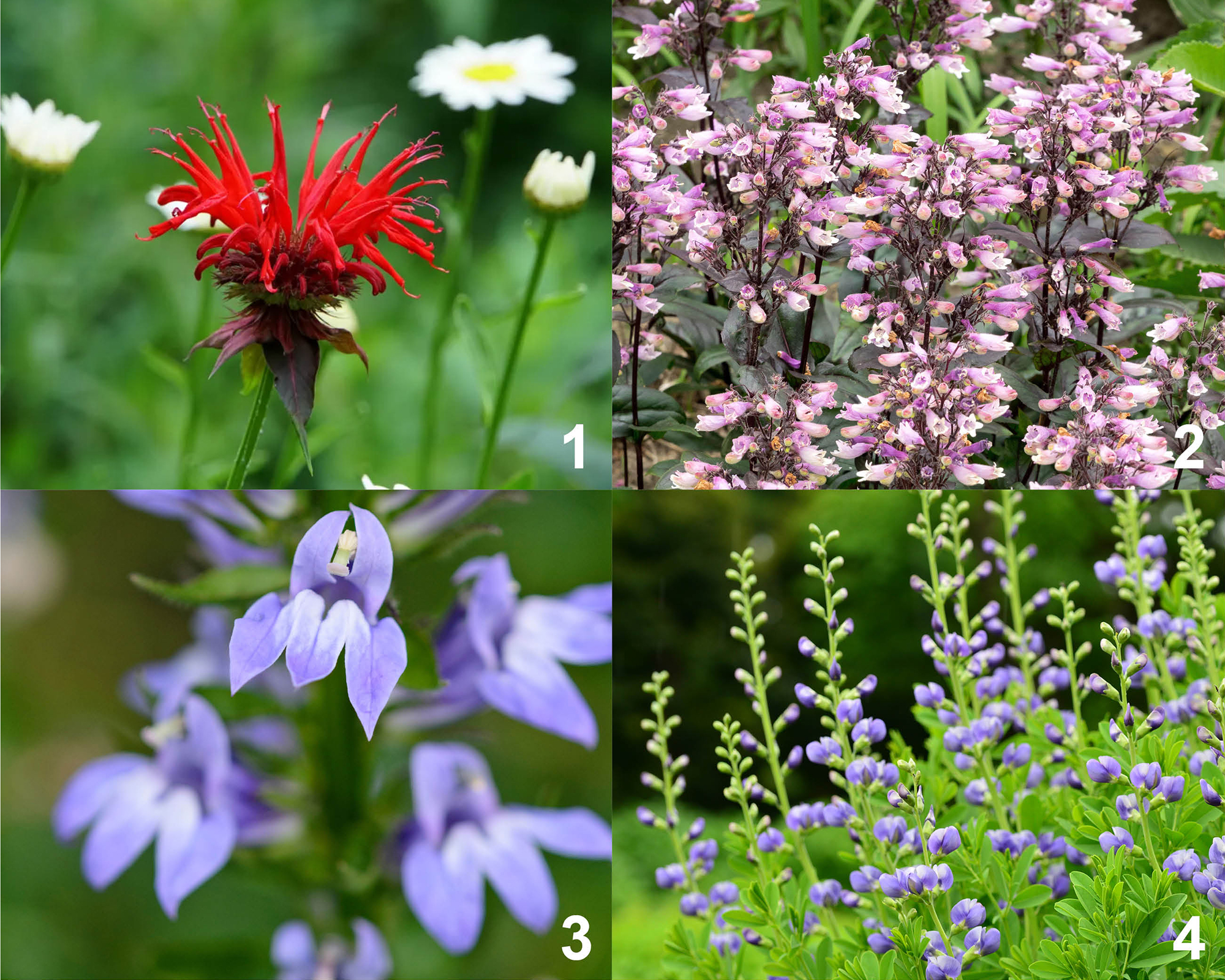
The world of perennials offers a daunting number of choices for hummingbird gardens. We’ve made it easier to choose by creating a Native Hummingbird Garden Kit in collaboration with Plant By Number, available on the Gardening Know How Shop.
Designed to fit into a 5ft x 5ft garden, the kit comes with a planting plan, fabric planting map, and plants that will attract and feed hummingbirds. All varieties here are partial to full sun, grow best in rich, well-draining soils, and are suited to USDA Zones 5-8. Each kit contains one of each of the following:
- Bee Balm ‘Raspberry Wine’ (Monarda) Its vivid red flowers are a favorite of hummingbirds and are sure to draw a crowd.
- Penstemon 'Dakota Burgundy' (Penstemon digitalis) Loads of nectar-rich blooms line its 2ft-tall flower spikes.
- Blue Cardinal Flower (Lobelia siphilitica) This deer- and rabbit-resistant perennial blooms late, ensuring food and fuel deep into the season.
- Blue False Indigo (Baptisia australis) A bushy perennial growing up to 4ft high over the course of several seasons, its stunningly blue to purple blooms attract hummingbirds, butterflies, and bees.
A second Native Hummingbird Garden Kit, available on the Gardening Know How Shop, expands this kit’s footprint into an 8ft x 5ft garden with the addition of two more penstemon 'Dakota Burgundy' and a 'Pardon My Cerise' bee balm, with its bounty of richly red, hummingbird-attracting blooms.
This article features products available from third-party vendors on the Gardening Know How Shop.

Ellen Wells is a horticultural communications consultant with 30 years of experience writing about all aspects of the gardening world.
She has worked for many of horticulture’s biggest brand names, writing blog posts, articles, press releases, and design and instructional pieces. Her previous roles include Senior Editor and Editor-at-Large for Ball Publishing.
Ellen is based in New England where she gardens in Zone 7a. She loves tending to flower-filled containers on the patio and puttering around her vegetable garden.
- Melanie GriffithsEditor in Chief